Investigating European Union Decarbonization Strategies: Evaluating the Pathway to Carbon Neutrality by 2050
Abstract
:1. Introduction
2. Materials and Methods
2.1. Data Resources
- (1)
- the adequacy of their national targets (in a net zero context);
- (2)
- the completeness and detail of the policy descriptions;
- (3)
- the quality and inclusiveness of the drafting process.
2.2. Scaling Methodology
2.2.1. NECPs Assessment
- Target Table: focuses on Member State’s objectives, targets and contributions under the Governance Regulation;
- ANNEX II: detailed assessment of how the EC recommendations to improve Draft NECPs have been addressed by the Member States in the Final NECPs.
- GHG binding reduction target (from 2005) under Effort Sharing Regulations;
- Target for the percentage of renewables share in the national gross final energy consumption;
- Energy efficiency in primary energy consumption;
- Energy efficiency in final energy consumption.
- Non -ETS GHG emissions: emissions reduction targets set in the Effort Sharing Regulation (ESR);
- EU renewable energy: share of renewable energy under existing and planned measures;
- Energy Efficiency: implementation of the “Energy Efficiency First” principle into legislation;
- Energy security: importance of a resilient energy system with appropriate business continuity plans;
- Internal energy market: well-functioning internal energy market provides price signals to guide investment in green energy and technologies, secures energy supplies and enables the least-cost path to climate neutrality through smart technologies;
- Research and Innovation: R&I needs for delivering on climate and energy objectives;
- Regional cooperation: increased cooperation between the Member States and multi-level dialogue;
- Investment and funding: expected investments needed to achieve the various objectives, targets and contributions;
- Energy subsidies: plan/list of actions to boost renewable; plan of phasing out energy subsidies for fossil fuels;
- Air quality: measures on air pollution, linked to environmental legislation;
- Just transition and energy poverty: measures to address the social and economic impacts of the transition, focusing on the regions, industries and workers who will face the greatest challenges.
- Number of recommendations = “fully” score value based on the number of recommendations;
- Fully score × judgement score (Table 3) = final score for recommendations;
- Objective score = sum of scores for each recommendation due to that objective;
- If a recommendation is N/A, the score is = 0;
- If a recommendation is “No Recommendations”, the score is = 1.
2.2.2. LTSs Assessment
- Overall goal of LTS;
- Scenarios presented in the LTS;
- GHG reductions;
- Renewable energy sources;
- Energy efficiency;
- Estimated Investment;
- Socio-Economic Impact of transition;
- Adaptation Policies measures;
- Public Consultation;
- Legal status of LTS and targets.
3. Results and Discussion
3.1. NECPs Assessment
3.1.1. Assessment of National Targets Ambition Level
- GHG binding reduction target (at 2005) under Effort Sharing Regulations;
- Target for the percentage share of renewables in the national gross final energy consumption;
- Energy efficiency in primary energy consumption;
- Energy efficiency in final energy consumption.
3.1.2. Assessment of the Implementation of EC Recommendations
3.1.3. Assessment of Progress since the Draft NECPs
3.2. LTS Assessment
4. Conclusions
- Both in NECPs and LTS, targets are, on average, well-assessed, while the principle of Energy Efficiency First, one of the most important leverages to achieve the decarbonization is not sufficiently addressed. The Member States privilege investment in new technologies.
- In NECPs, despite the EU27 Energy provisioning looking well-planned in terms of the energy market and Energy security, insufficient attention is given to Research and Development, even as countries establish clear targets in renewable share and other green production targets.
- In NECPs, incentives and subsidies are, on average, addressed: however, many EU Member States still do not have a coal phase-out plan by 2030. Other countries are planning to replace coal with natural gas and are pushing for the use of EU funds to co-finance investments in natural gas infrastructure.
- In NECPs the evaluation of the social impact of the transition is still only partially addressed.
- In LTS, most of the planned objectives are still addressed only partially or low; as for the NECPs, the 2050 targets are generally clearly set, even the scenarios to achieve them. On the other side, financial estimations, the socio-economic impact of the transition and overall long-term policy are not yet sufficiently set.
- Building sectors decarbonization has been prioritized among all the other actions.
- The COVID−19 crisis unexpectedly brings the EU very close to reaching the 2020 energy efficiency targets. However, this is not the result of structural changes, and therefore it will lead to a rebound in energy consumption, which means that additional energy efficiency efforts and investments are needed.
- The recent crisis in Ukraine will affect the energy market and the energy provision for EU27, especially for natural gas, although uncertainty remains as to how this will impact the net zero pathways.
Supplementary Materials
Author Contributions
Funding
Institutional Review Board Statement
Informed Consent Statement
Data Availability Statement
Conflicts of Interest
References
- Andersen, M.S. An introductory note on the environmental economics of the circular economy. Sustain. Sci. 2007, 2, 133–140. [Google Scholar] [CrossRef]
- Ghisellini, P.; Cialani, C.; Ulgiati, S. A review on circular economy: The expected transition to a balanced interplay of environmental and economic systems. J. Clean. Prod. 2015, 114, 11–32. [Google Scholar] [CrossRef]
- Haas, W.; Krausmann, F.; Wiedenhofer, D.; Heinz, M. How Circular is the Global Economy?: An Assessment of Material Flows, Waste Production, and Recycling in the European Union and the World in 2005. J. Ind. Ecol. 2015, 19, 5. [Google Scholar] [CrossRef]
- Mora, C.; Spirandelli, D.; Franklin, E.C.; Lynham, J.; Kantar, M.B.; Miles, W.; Smith, C.Z.; Freel, K.; Moy, J.; Louis, L.V.; et al. Broad threat to humanity from cumulative climate hazards intensified by greenhouse gas emissions. Nat. Clim. Chang. 2018, 8, 1062–1071. [Google Scholar] [CrossRef]
- Maris, G.; Flouros, F. The Green Deal, National Energy and Climate Plans in Europe: Member States’ Compliance and Strategies. Adm. Sci. 2021, 11, 75. [Google Scholar] [CrossRef]
- Paoli, L.D.; Geoffron, P. Introduction. A critical overview of the European National Energy and Climate Plans. Econ. Policy Energy Environ. 2019, LXI, 31–41. [Google Scholar] [CrossRef]
- Balode, L.; Dolge, K.; Lund, P.D.; Blumberga, D. How to Assess Policy Impact in National Energy and Climate Plans. Environ. Clim. Technol. 2021, 25, 405–421. [Google Scholar] [CrossRef]
- Williges, K.; Van der Gaast, W.; de Bruyn-Szendrei, K.; Tuerk, A.; Bachner, G. The potential for successful climate policy in National Energy and climate plans: Highlighting key gaps and ways forward. Sustain. Earth 2022, 5, 1. [Google Scholar] [CrossRef]
- Zell-Ziegler, C.; Thema, J.; Best, B.; Wiese, F.; Lage, J.; Schmidt, A.; Toulouse, E.; Stagl, S. Enough? The role of sufficiency in European energy and climate plans. Energy Policy 2021, 157, 112483. [Google Scholar] [CrossRef]
- European Commission. Regulation (EU) 2018/1999 of the European Parliament and of the Council. 2018. Available online: https://eur-lex.europa.eu/legal-content/EN/TXT/?toc=OJ:L:2018:328:TOC&uri=uriserv:OJ.L_.2018.328.01.0001.01.ENG (accessed on 17 February 2022).
- European Commission. European Climate Law. 2021. Available online: https://eur-lex.europa.eu/eli/reg/2021/1119/oj (accessed on 30 January 2022).
- European Commission. Delivering the Energy Union and Climate Action—Setting the Foundations for a Successful Clean Energy Transition. 2019. Available online: https://eur-lex.europa.eu/legal-content/EN/TXT/PDF/?uri=CELEX:52019DC0285&rid=5 (accessed on 18 January 2019).
- Roberts, J.; Gauthier, C. Energy Communities in the Draft National Energy and Climate Plans: Encouraging but Room for Improvements; REScoop: Berchem, Belgium, 2019. [Google Scholar]
- Duwe, M.; Velten, E.K.; Evans, N.; Freundt, M.; Pestiaux, J.; Benoit, M.; Vermeulen, P. Planning for net-zero: Assessing the Draft National Energy and Climate Plans; Net Zero 2050; Ecologic Institute: Berlin, Germany, 2019; Available online: https://www.ecologic.eu/16573 (accessed on 31 January 2022).
- European Commission. An EU-Wide Assessment of National Energy and Climate Plans. Available online: https://eur-lex.europa.eu/legal-content/EN/TXT/?uri=COM:2020:564:FIN (accessed on 12 April 2022).
- European Commission. NEPCs Individual Assessments. 2021. Available online: https://energy.ec.europa.eu/individual-assessments_en (accessed on 4 May 2021).
- European Commision. Amending Directive 2003/87/EC Establishing a System for Greenhouse Gas Emission Allowance Trading within the Union, Decision (EU) 2015/1814 Concerning the Establishment and Operation of a Market Stability Reserve for the Union Greenhouse Gas Emission Trading Scheme and Regulation (EU) 2015/757. 2021. Available online: https://ec.europa.eu/info/sites/default/files/revision-eu-ets_with-annex_en_0.pdf (accessed on 12 April 2022).
- Ricardo. Long Term Strategy Summary Tables. Available online: https://ec.europa.eu/info/energy-climate-change-environment/implementation-eu-countries/energy-and-climate-governance-and-reporting/national-long-term-strategies_en (accessed on 4 March 2022).
- Dunn-Rankin, P.; Knezek, G.A.; Wallace, S.R.; Zhang, S. Scaling Methods; Psychology Press: Hove, UK, 2014. [Google Scholar]
- Hensley, R.L. A review of operations management studies using scale development techniques. J. Oper. Manag. 1999, 17, 343–358. [Google Scholar] [CrossRef]
- Tullis, T.; Albert, B. Chapter 6—Self-Reported Metrics. In Measuring the User Experience, 2nd ed.; Tullis, T., Albert, B., Eds.; Morgan Kaufmann: Boston, MA, USA, 2013; pp. 121–161. ISBN 978-0-12-415781-1. [Google Scholar] [CrossRef]
- Ploder, A.; Eder, A. Semantic Differential. In International Encyclopedia of the Social & Behavioral Sciences, 2nd ed.; Wright, J.D., Ed.; Elsevier: Oxford, UK, 2015; pp. 563–571. ISBN 978-0-08-097087-5. [Google Scholar] [CrossRef]
- European Commision. Energy Efficiency First. Available online: https://energy.ec.europa.eu/topics/energy-efficiency/energy-efficiency-targets-directive-and-rules/energy-efficiency-first_en (accessed on 12 April 2022).
- European Commision. A Renovation Wave for Europe—Greening our Buildings, Creating Jobs, Improving Lives. 2020. Available online: https://eur-lex.europa.eu/legal-content/EN/TXT/?qid=1603122220757&uri=CELEX:52020DC0662 (accessed on 12 April 2022).
- Staniaszek, D.; Volt, J.; de Groote, M.; Fabbri, M.; Rapf, O. Building renovation: The sustainable path to improving energy security in Central and South-Eastern Europe. Energy Effic. 2019, 12, 315–325. [Google Scholar] [CrossRef]
- Mata Pérez, M.; Scholten, D.; Smith Stegen, K. The multi-speed energy transition in Europe: Opportunities and challenges for EU energy security. Energy Strategy Rev. 2019, 26, 100415. [Google Scholar] [CrossRef]
- Duch-Brown, N.; Rossetti, F. Digital platforms across the European regional energy markets. Energy Policy 2020, 144, 111612. [Google Scholar] [CrossRef]
- Markopoulou, D.; Papakonstantinou, V.; de Hert, P. The new EU cybersecurity framework: The NIS Directive, ENISA’s role and the General Data Protection Regulation. Comput. Law Secur. Rev. 2019, 35, 105336. [Google Scholar] [CrossRef]
- European Commision. InvestEU. Available online: https://europa.eu/investeu/about-investeu_en (accessed on 12 April 2022).
- European Commision. NextGeneration EU. Available online: https://europa.eu/next-generation-eu/index_en (accessed on 12 April 2022).
- Nowag, J.; Mundaca, L.; Åhman, M. Phasing out fossil fuel subsidies in the EU? Exploring the role of state aid rules. Clim. Policy 2021, 21, 1037–1052. [Google Scholar] [CrossRef]
- Zhu, E.; Campbell, L.; Hafner, M.; Lu, X.; Noussan, M.; Raimondi, P.P. Towards An Inclusive Energy Transition Beyond Coal A Comparison of Just Transition Policies away from Coal between CHINA, the EU and the US; Nota di Lavoro 36.2021; Fondazione Eni Enrico Mattei: Milano, Italy, 2021; p. 32. [Google Scholar]
- Strambo, C. Just Transition and the Geopolitics of Decarbonization in the EU 2020; Stockholm Environment Institute: Stockholm, Sweden, 2020. [Google Scholar]
- European Commision. Establishing a Social Climate Fund. 2021. Available online: https://eur-lex.europa.eu/legal-content/EN/TXT/?uri=CELEX:52021PC0568 (accessed on 12 April 2022).
- European Commission. Analysis of the National Long-Term Renovation Strategies—Staff Work Document. 2021. Available online: https://energy.ec.europa.eu/system/files/2021-12/swd-on-national-long-term-renovation-strategies.pdf (accessed on 12 April 2022).
- European Union. Update of the NDC of the European Union and its Member States. 2020. Available online: https://www4.unfccc.int/sites/ndcstaging/PublishedDocuments/European%20Union%20First/EU_NDC_Submission_December%202020.pdf (accessed on 12 April 2022).
- UNFCCC. Outcomes of the Glasgow Climate Change Conference. Available online: https://unfccc.int/process-and-meetings/conferences/glasgow-climate-change-conference-october-november-2021/outcomes-of-the-glasgow-climate-change-conference (accessed on 12 April 2022).
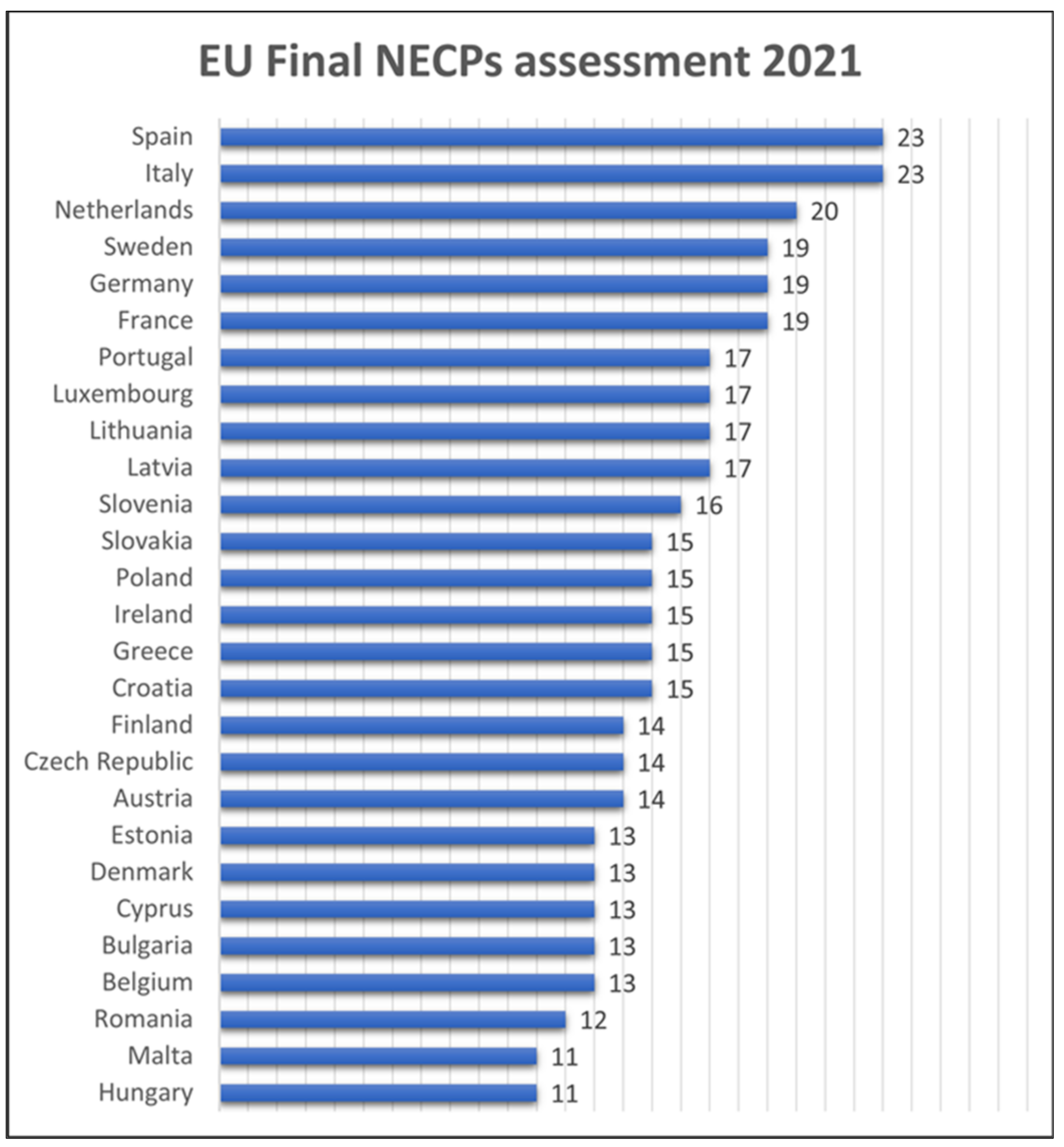
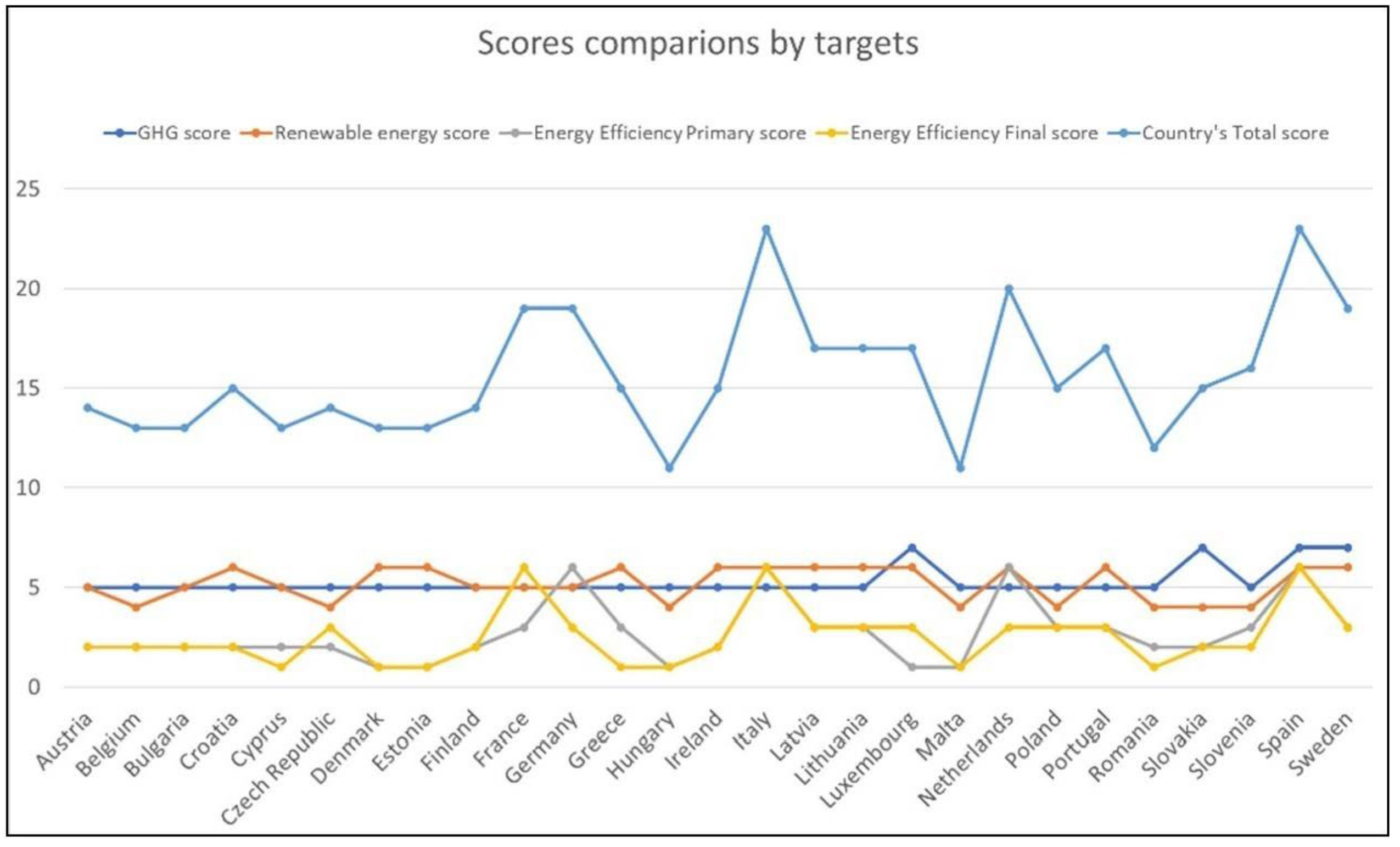
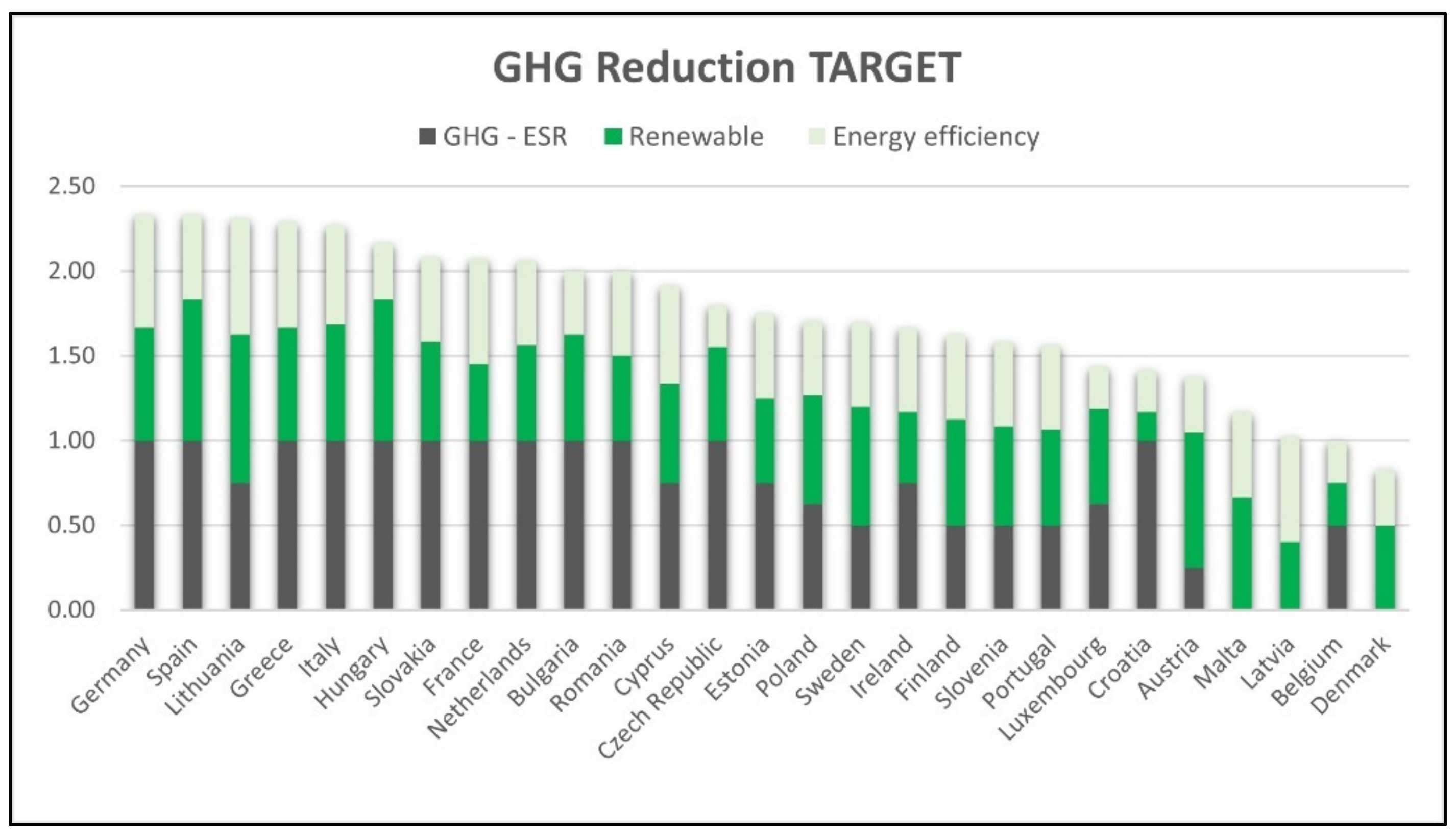
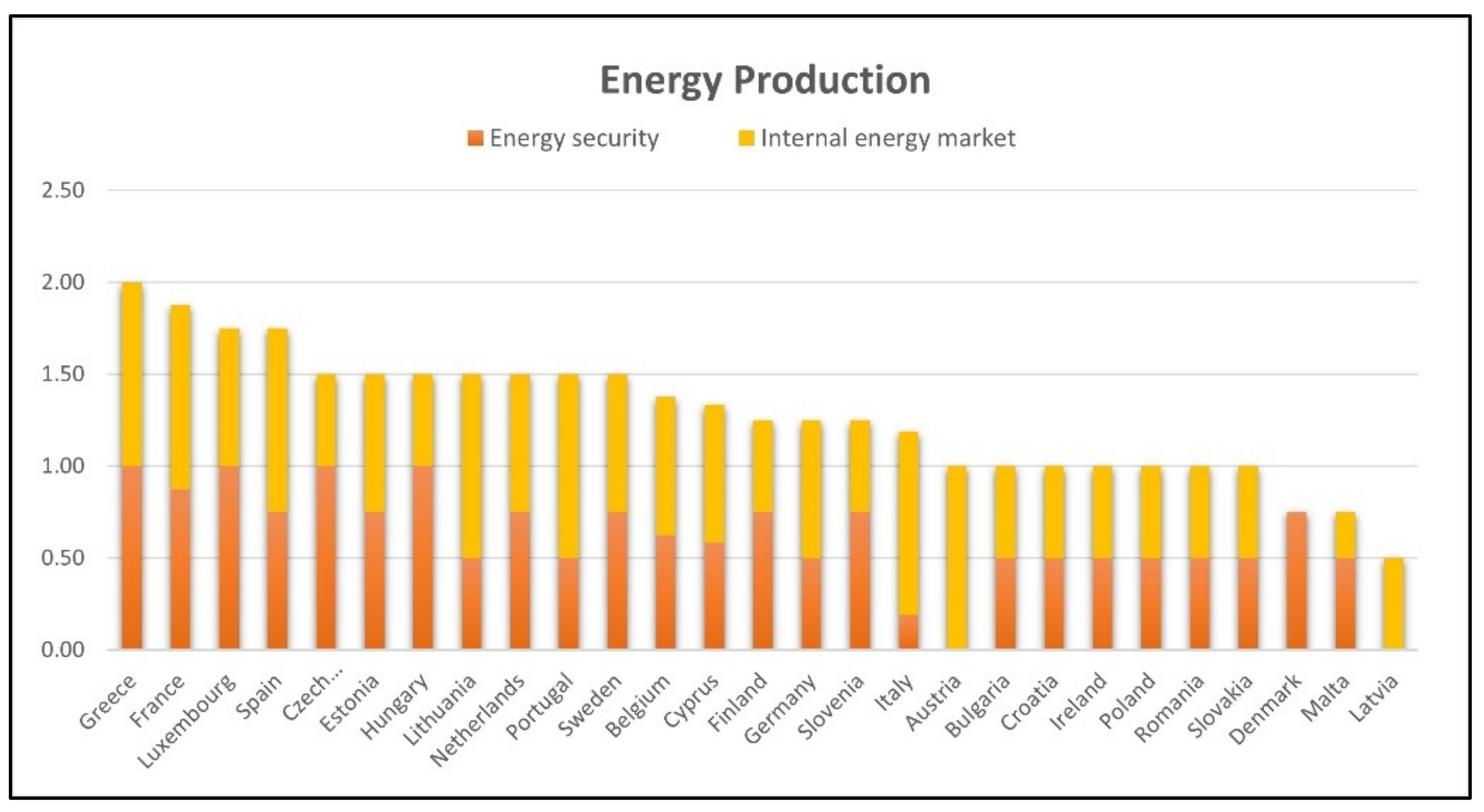
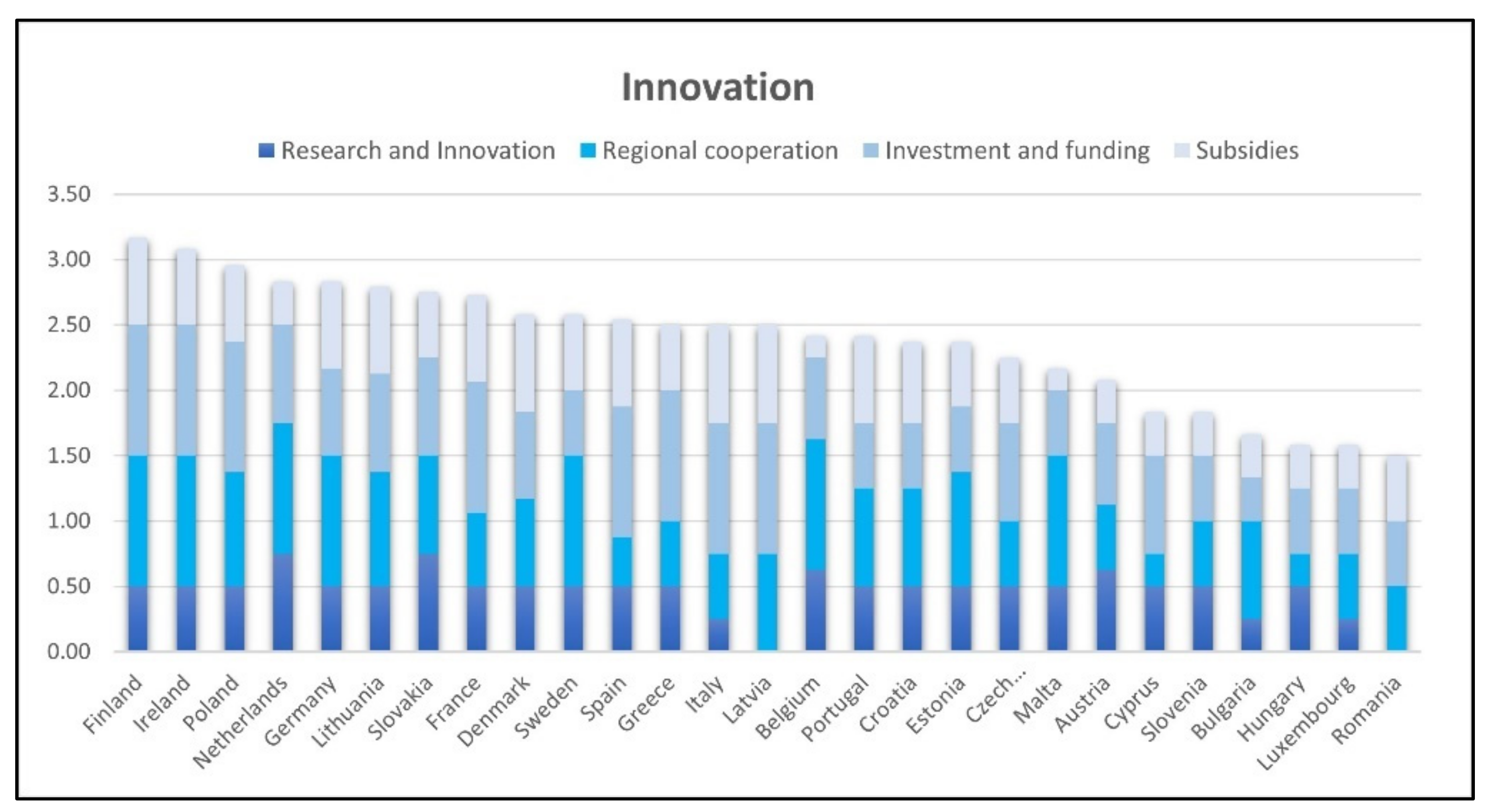

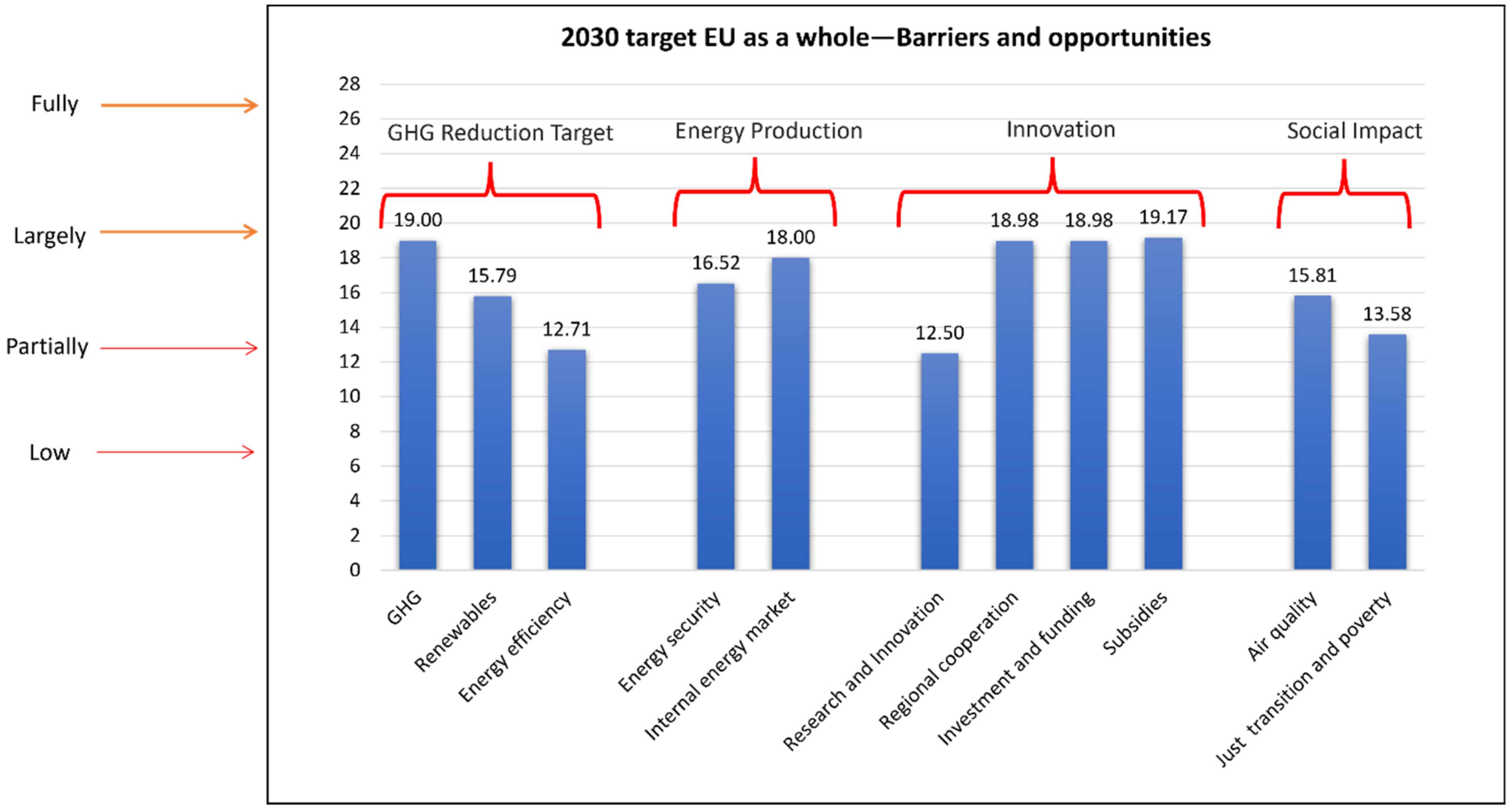
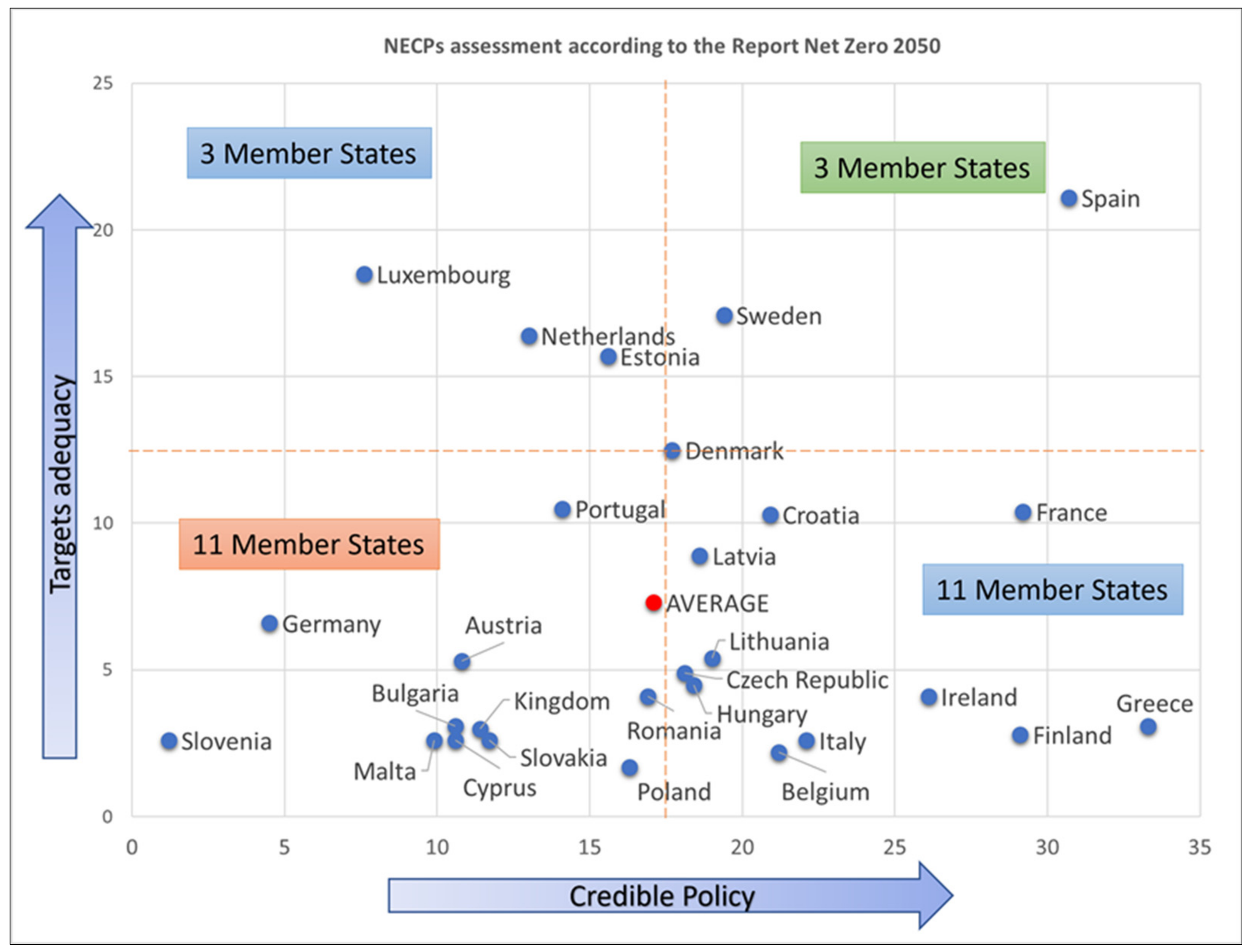
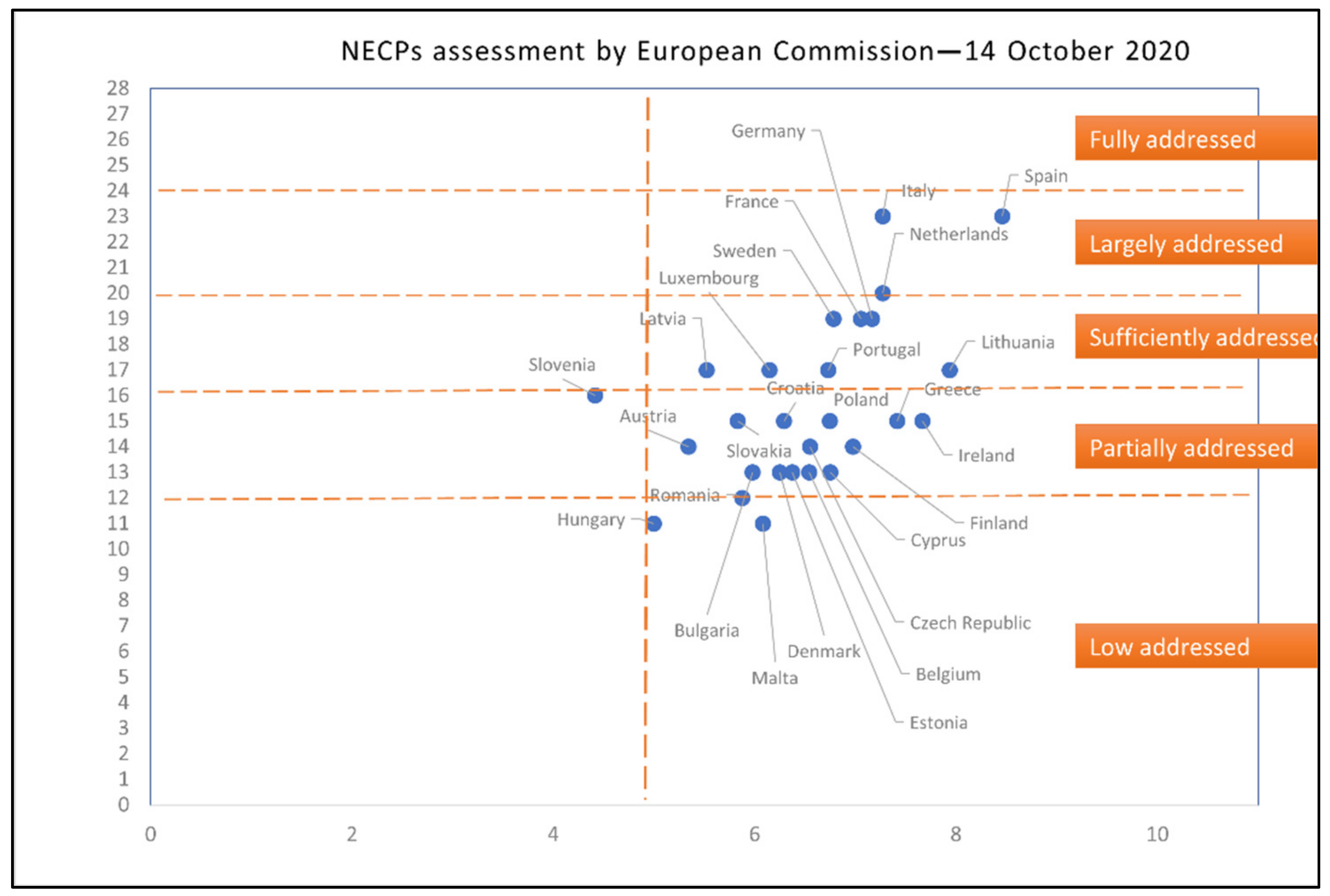
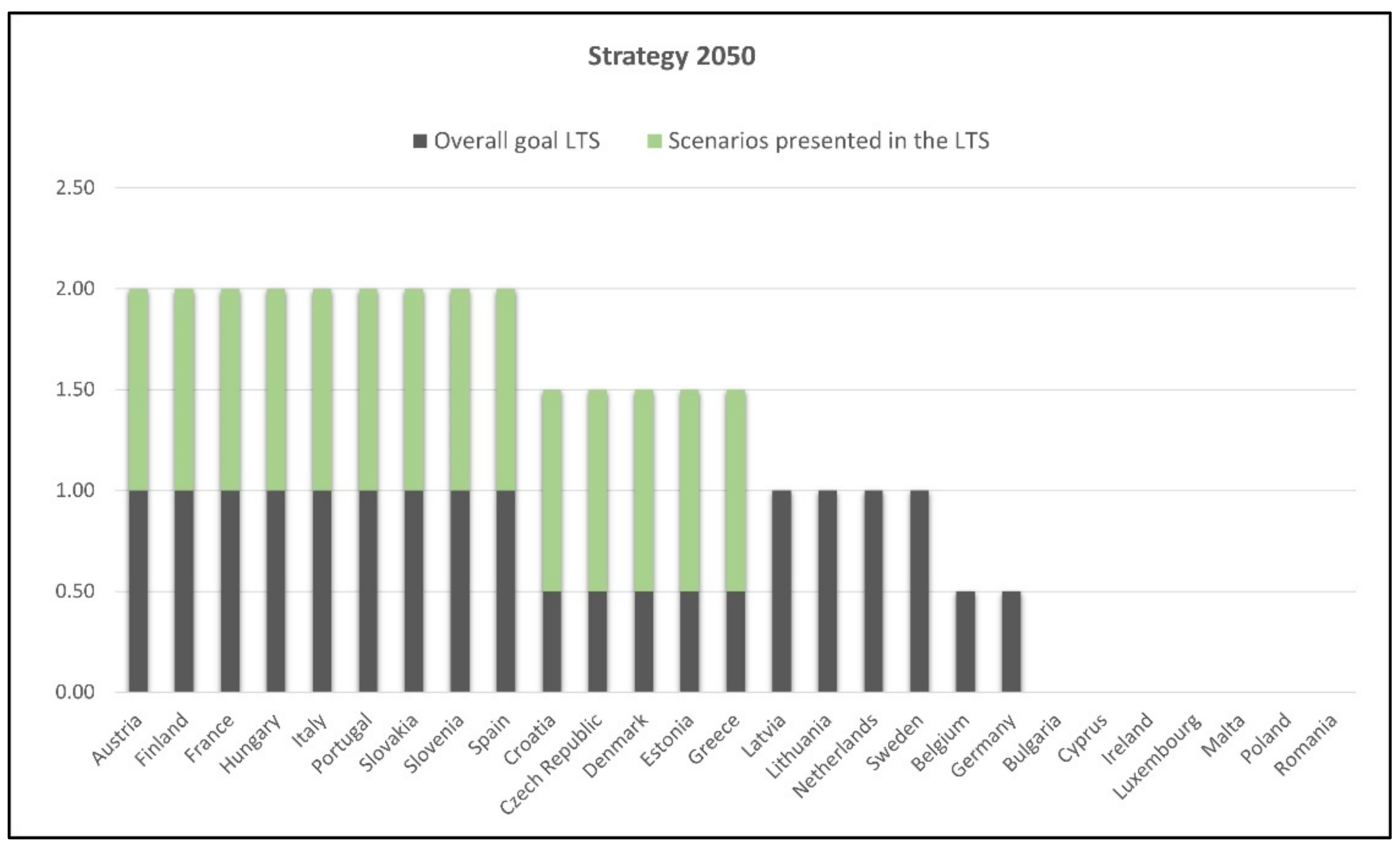
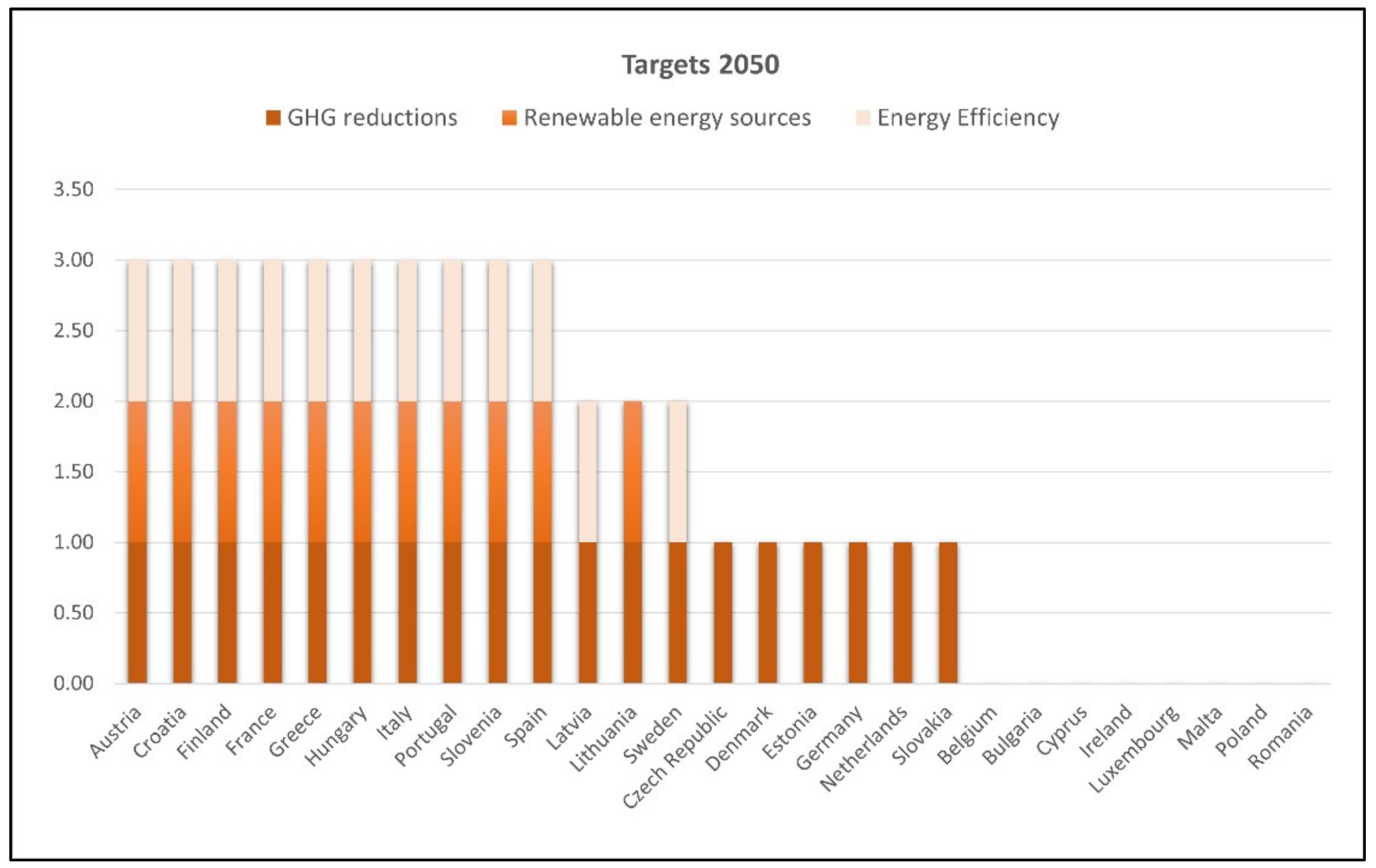
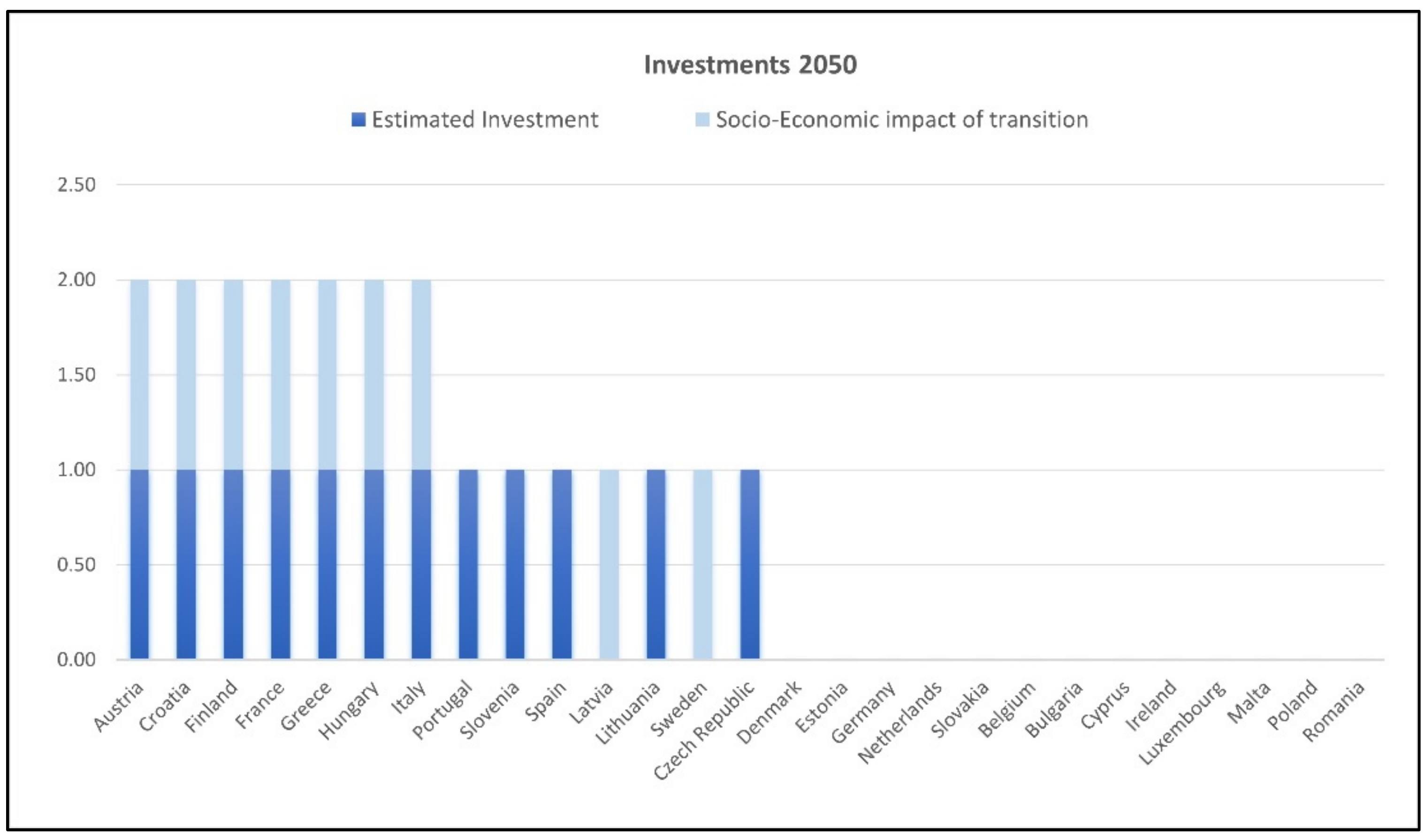
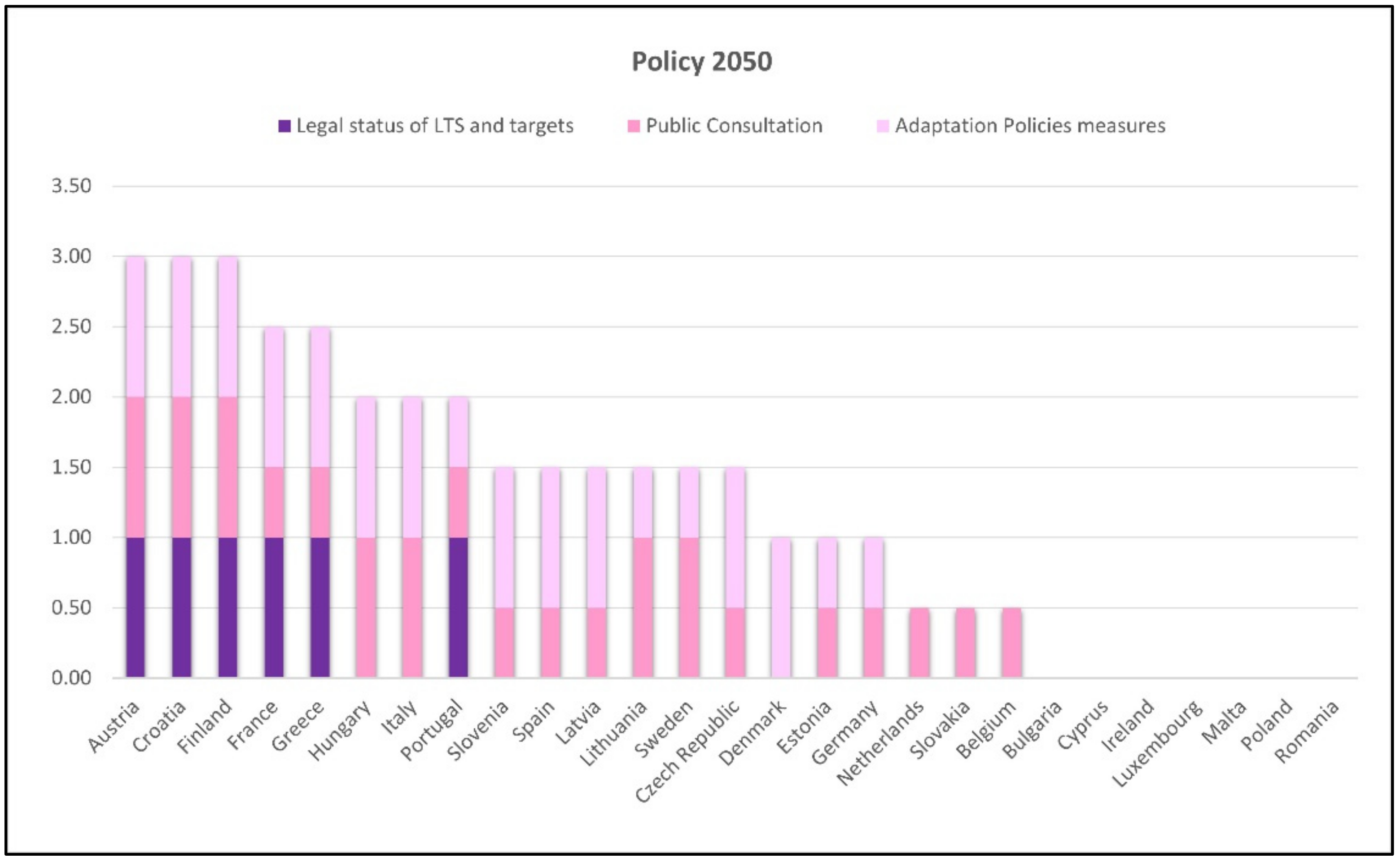

| Targets’ Judgement | Score |
|---|---|
| more ambitious | 7 |
| sufficiently ambitious (including “As in ESR”) | 6 |
| adequate | 5 |
| not ambitious | 4 |
| modest | 3 |
| low | 2 |
| very low | 1 |
| not addressed (N/A) | 0 |
| Level of Addressing | Ranges | |
|---|---|---|
| fully addressed | 24 | 28 |
| largely addresses | 21 | 24 |
| sufficiently addressed | 17 | 20 |
| partially addressed | 12 | 16 |
| low addressed | 9 | 12 |
| very low addressed | 5 | 8 |
| not addressed | 0 | 4 |
| Targets’ Judgement | Score |
|---|---|
| Fully | 1.00 |
| Largely | 0.75 |
| Partially | 0.5 |
| N/A | 0 |
| Austria—Recommendations | ||||
|---|---|---|---|---|
| Recommendations | Recommendations per Objective | Assessment Judgement | Score | |
| 1 | Decarbonization—GHG | 2 | partially | 0.25 |
| NA | 0.00 | |||
| 2 | Renewables share | 5 | fully | 0.20 |
| fully | 0.20 | |||
| partially | 0.10 | |||
| partially | 0.10 | |||
| fully | 0.20 | |||
| 3 | Energy efficiency | 3 | partially | 0.17 |
| NA | 0.00 | |||
| partially | 0.17 | |||
| 4 | Energy security | 1 | NA | 0.00 |
| 5 | Internal energy market | 1 | No rec | 1.00 |
| 6 | Research and Innovation | 2 | largely | 0.38 |
| partially | 0.25 | |||
| 7 | Regional cooperation | 3 | partially | 0.17 |
| partially | 0.17 | |||
| partially | 0.17 | |||
| 8 | Investment and funding | 2 | largely | 0.38 |
| partially | 0.25 | |||
| 9 | Energy subsidies | 3 | partially | 0.17 |
| NA | 0.00 | |||
| partially | 0.17 | |||
| 10 | Air quality | 1 | partially | 0.50 |
| 11 | Just transition and energy poverty | 2 | NA | 0.00 |
| largely | 0.38 | |||
| Total score | 5.38 |
| Level of Addressing | Ranges | |
|---|---|---|
| fully/no recommendation | 27 | |
| largely | >20.25 | <27 |
| partially | >13.5 | <20.25 |
| low | >0 | <13.5 |
| N/A | 0 | |
| Targets’ Judgement | Score |
|---|---|
| Quantitative data and information | 1 |
| yes | 1 |
| limited | 0,5 |
| N/A or No or unspecified | 0 |
| GHG Reduction Target | Energy Production | Innovation | Social Impact |
|---|---|---|---|
| non-ETS GHG emissions | Energy security | Regional cooperation | Air quality measures |
| EU renewable energy share | Internal energy market | Investment and funding | Just transition and energy poverty |
| Energy Efficiency | Energy subsidies | ||
| Research and Innovation |
| Objectives | Scores |
|---|---|
| GHG | 19.00 |
| Renewables | 15.79 |
| Energy efficiency | 12.71 |
| Energy security | 16.52 |
| Internal energy market | 18.00 |
| Research and Innovation | 12.50 |
| Regional cooperation | 18.98 |
| Investment and funding | 18.98 |
| Subsidies | 19.17 |
| Air quality | 15.81 |
| Just transition and poverty | 13.58 |
| Strategy | Targets | Investments | Policy |
|---|---|---|---|
| Overall goal LTS | GHG reductions | Estimated Investment | Adaptation Policies measures |
| Scenarios presented in the LTS | Renewable energy sources | Socio-Economic Impact of transition | Public Consultation |
| Energy Efficiency | Legal status of LTS and targets |
| Objectives | Scores |
|---|---|
| Overall goal LTS | 16.50 |
| Scenarios presented in the LTS | 14.00 |
| GHG reductions | 19.00 |
| Renewable energy sources | 11.00 |
| Energy Efficiency | 12.00 |
| Estimated Investment | 12.00 |
| Socio-Economic impact of transition | 9.00 |
| Adaptation Policies measures | 14.50 |
| Public Consultation | 13.00 |
| Legal status of LTS and targets | 6.00 |
Publisher’s Note: MDPI stays neutral with regard to jurisdictional claims in published maps and institutional affiliations. |
© 2022 by the authors. Licensee MDPI, Basel, Switzerland. This article is an open access article distributed under the terms and conditions of the Creative Commons Attribution (CC BY) license (https://creativecommons.org/licenses/by/4.0/).
Share and Cite
Perissi, I.; Jones, A. Investigating European Union Decarbonization Strategies: Evaluating the Pathway to Carbon Neutrality by 2050. Sustainability 2022, 14, 4728. https://doi.org/10.3390/su14084728
Perissi I, Jones A. Investigating European Union Decarbonization Strategies: Evaluating the Pathway to Carbon Neutrality by 2050. Sustainability. 2022; 14(8):4728. https://doi.org/10.3390/su14084728
Chicago/Turabian StylePerissi, Ilaria, and Aled Jones. 2022. "Investigating European Union Decarbonization Strategies: Evaluating the Pathway to Carbon Neutrality by 2050" Sustainability 14, no. 8: 4728. https://doi.org/10.3390/su14084728
APA StylePerissi, I., & Jones, A. (2022). Investigating European Union Decarbonization Strategies: Evaluating the Pathway to Carbon Neutrality by 2050. Sustainability, 14(8), 4728. https://doi.org/10.3390/su14084728







